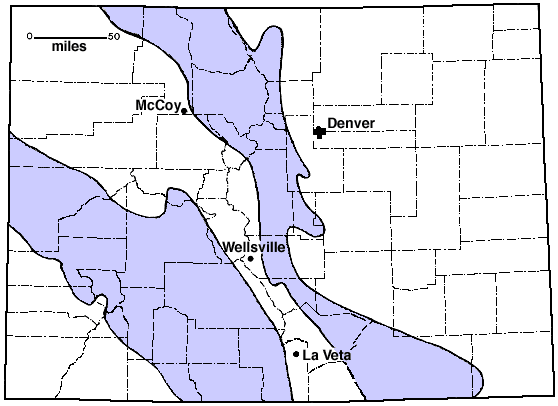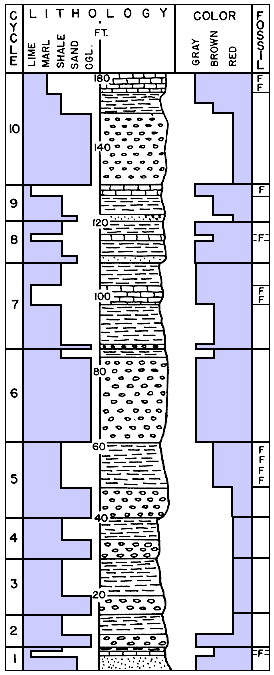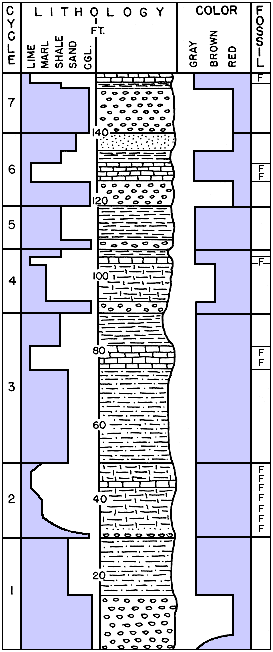
 |
Original published in D.F. Merriam, ed., 1964, Symposium on cyclic sedimentation: Kansas Geological Survey, Bulletin 169, pp. 63-68 | |
University of Colorado, Boulder, Colorado
Prominent and distinct cycles in sedimentation, especially in the Central Colorado Trough between the highlands, indicate to a considerable extent details of the state's history during that time. In many places the most striking feature of the cycles is their sharp color alternation, from gray to red, but texturally the changes are equally notable. The cycles can be characterized as consisting of a red conglomeratic arkose overlain by a unit of finer texture which may be red, brown, gray or mottled shaly sandstone or shale, finally covered by a fossiliferous gray or greenish gray marine limestone. Usually a thin bed of intermediate texture occurs between the limestone and the next succeeding coarse clastic unit. Variations in color and texture are great, however. Contacts between the beds in most instances are sharp and frequently appear unconformable, indicating abrupt changes in deposition.
Figure 1--State of Colorado, showing location of sections described. During Pennsylvanian time, shaded areas are believed to have been positive and shedding sediments, unshaded areas negative and receiving sediments. Western landmass is Uncompahgre Uplift or "Uncompahgria," and eastern one is Ancestral Rockies and Sierra Grande Uplift, or "Frontrangia" and "Apishapaia." Central unshaded area is Central Colorado Trough (after Mallory, 1958).

In order to demonstrate in detail the nature of Colorado cyclic deposits, parts of sections from three localities (Fig. 1) are presented. The selected interval represents the most characteristically alternating sequence of beds in the column. Beside each of the columnar diagrams, graphs have been constructed showing variations in lithology and color, and a notation has been made where marine fossils occur in the section. Boundaries of the cycles have been chosen at the base of the coarsest lithology in each alternation on the presumption that this is the most likely position of unconformity in the section.
The geologic age of the sections illustrated is reasonably well known from fossil evidence. In the McCoy locality (Fig. 2) fusulinids are abundant in several beds and indicate an early Desmoinesian age for the interval. The Wellsville section (Fig. 3) contains the primitive fusulinid Millerella, but no more advanced type, and is thought to be of Morrowan age. At La Veta Pass (Fig. 4), fusulinids indicate a late Atokan and early Desmoinesian age for the cycles figured. No outcropping marine cycles younger in age than Desmoinesian are known in the Central Colorado Trough, although in both eastern and western Colorado such cycles do exist.
The fauna of the Colorado cycles occurs mostly in gray limestones, marls, and shales, but locally marine fossils are present in the coarser or nongray beds. At McCoy, brachiopods and bellerophontid gastropods occur in abundance in a mottled red and gray shale which contains some nodules of limestone (Walker, 1959), and they are rarely found in coarser redbeds. Usually, the occurrence of marine fossils in redbeds in Colorado is limited to a few genera or species, whereas in the gray beds the fauna may be several times as diverse, suggesting that although the redbed depositional environment was adequate for some forms of marine life, many forms were not able to live there. That color and not texture of beds may be the limiting environmental factor for abundant and varied life is indicated by the fact that in several sections, gray sandstones or conglomerates contain many relatively unabraded large fossils, whereas they are virtually absent in equally coarse-textured redbeds. In only one case, at McCoy, has a typically marine fossil been found in a coarse red arkose. In this instance the large coiled nautiloid, modern descendants of which are known to float long distances after death, probably was not indigenous to the depositional environment. The question of whether the red color in the redbeds was present at the time of deposition of the beds, or developed later through chemical action, cannot be explored in detail here, but the relations of fossils to their enclosing rocks in the Colorado Pennsylvanian suggests that there was an original environmental difference between the red and nonred beds.
It seems likely on the basis of faunal evidence that a typical marine environment may have been present during deposition of most of the gray or greenish gray parts of the cycles, but not during deposition of the red parts of most cycles.
Figure 2--McCoy Cyclic Pennsylvanian Section. Beds below and above this section are of Pennsylvanian age. Under color column, in addition to those beds which are dominantly brown, mottled beds which may be a mixture of red and gray are characterized as brown, for purposes of comparison.

Lateral variation in the beds of the cycles is extreme at McCoy, as entire cycles may wedge out in a distance of less than a mile, whereas others appear as rapidly, so that regional correlation of these units is impossible. In general, the cycles become more marine toward the west or northwest, and consist mainly of marine limestones, because the strandline occurred at or just east of McCoy, with alternations back and forth from east to west having caused the local cycles of deposition (Chronic and Stevens, 1958). Ten miles to the east at Radium, the cycles are absent, and the Paleozoic section consists of a few feet of redbeds which are probably younger than those at McCoy.
Figure 3--Wellsville Cyclic Pennsylvanian Section. Beds below and above this section are Pennsylvanian in age.

Two of the limestones in this section, those of cycles 3 and 4, are noteworthy in having a thin (1 mm or less), dark greenish gray layer of material on their upper surface, and this substance also coats many of the fossils in this section. This compound has been tentatively identified as one of the kaolinite minerals (Stough, 1956), although it appears chloritic in nature. It is suspected, but by no means proved, that stagnant, highly reducing conditions during or at the close of deposition of the limestones and marls, coupled with a lack of clastic sediment, may have caused the formation of these deposits.
Color in the Wellsville section is generally consistent within the cycles, changing upward from red to gray as the lithology becomes finer and more calcareous. The lack of red colors in the coarser beds of cycles 1 and 4 may be related to the abundance of marine fossils in the immediately overlying rocks, or they may have been caused by their original depositional environment. Otherwise, an excellent correlation between marine fossil content and color of rock is evident here.
Figure 4--La Veta Pass Cyclic Pennsylvanian Section. Beds below and above this section are Pennsylvanian in age.

Variability in thickness of cycles is extreme here, ranging from 12 to 40 feet with an average of 26 feet. Laterally, the La Veta cycles illustrated here are relatively continuous, and there are no obvious local pinchouts, although individual cycles have not yet been correlated for more than a fraction of a mile. Contacts and color contrasts are not nearly so prominent in this section as in the more northerly Wellsville and McCoy sequences.
The cycles range widely in thickness and in lithology both vertically and horizontally, and certain correlation between individual cycles or beds has not been possible for more than a few miles. The nature of many of the coarsest beds in the cycles suggests a nonmarine origin for these units, but some of the fine textured and more evenly bedded clastics as well as the carbonate-rich beds were deposited under marine conditions. In the Central Colorado Trough at least, the most cyclic part of the Pennsylvanian section is of Morrowan, Atokan, and Desmoinesian age; no post-Desmoinesian marine cycles have yet been found there. The sharp contacts between successive beds within the cycles as well as between the cycles themselves suggests sudden periodic adjustments in sedimentation and environment as a result of tectonism or torrential deposition, or a complex combination of the two.
With such widespread occurrence of these distinctive cyclic deposits very near to recognized areas of extreme tectonic movement during Pennsylvanian time, it is tempting to theorize not only that the orogeny in Colorado was periodic in nature, but that its successive movements were at least partly the cause of the cyclothems in central United States and perhaps elsewhere.
Brill, K. G., 1952, Stratigraphy in the Permo-Pennsylvanian zeugogeosyncline of Colorado and northern New Mexico: Geol. Soc. America Bull., v. 63, p. 809-880.
Chronic, John, and Stevens, Calvin, 1958, Pennsylvanian paleogeography in the McCoy area, Eagle County, Colorado, in Symposium on Pennsylvanian rocks of Colorado and adjacent areas: Rocky Mountain Assoc. Geol., p. 86-90.
Litsey, L. R., 1958, Stratigraphy and structure of the northern Sangre de Cristo Mountains, Colorado: Geol. Soc. America Bull., v. 69, p. 1143-1178.
Mallory, W. W., 1958, Pennsylvanian coarse arkosic redbeds and associated mountains in Colorado, in Symposium on Pennsylvanian rocks of Colorado and adjacent areas: Rocky Mountain Assoc. Geol., p. 17-20.
Melton, F. A., 1925, Correlation of Permo-Carboniferous redbeds in southeast Colorado and northern New Mexico: Jour. Geology, v. 33, p. 807-814.
Roth, Robert, and Skinner, John, 1930, The fauna of the McCoy Formation, Pennsylvanian, of Colorado: Jour. Paleontology, v. 4, p. 332-352.
Stough, J. B., 1956, A statistical study of some Pennsylvanian faunas near Wellsville, Colorado: Unpub. master's thesis, Colorado Univ., p. 1-91.
Walker, T. R., 1959, Fossiliferous marine redbeds in Minturn Formation (Desmoines) near McCoy, Colorado: Am. Assoc. Petroleum Geologists Bull., v. 43, p. 1069-1071.